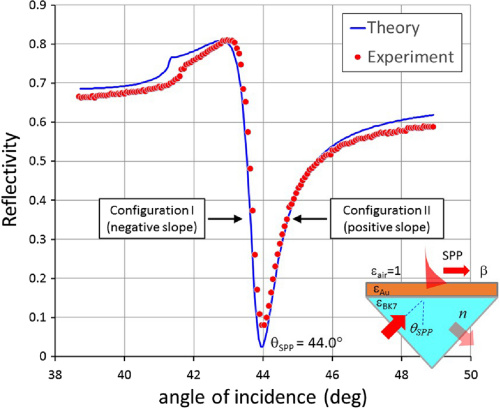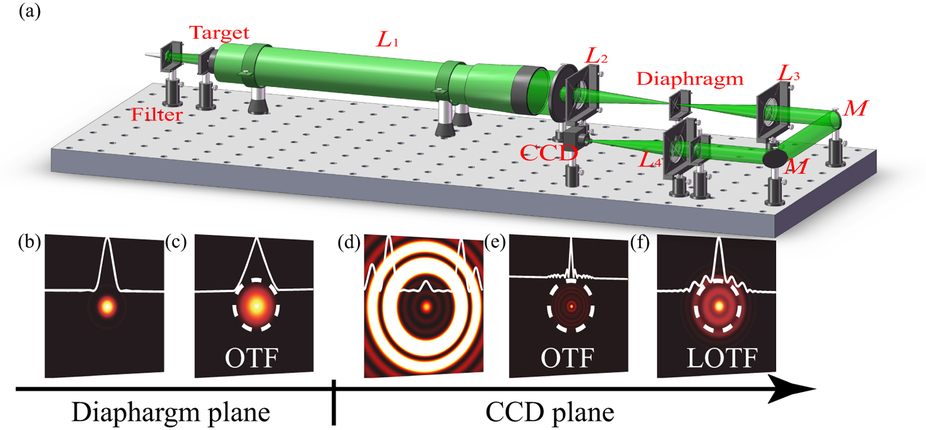一、本期重点
published:2015/12/8
内容介绍:
通常,对于光束波前像差的测量主要基于干涉测量方法(如剪切干涉仪)和波前斜率测量方法(如哈特曼传感器)。该文章提出了一种与这些传统方法不同的新观点:利用表面等离子体强度对入射光角度的不同来探测波前斜率,从而为重建波前像差提供了可能。


图一、左图:表面等离子体激发的衰减总内反射系数同光入射角的关系;右图:测量波前微分的实验装置。DM:可变形反射镜。HS WFS:哈特曼波前传感器。
所提出的波前传感器的核心是一个棱镜和金薄膜组成的表面等离体激发装置。如图一左图所示,在表面等离子体共振角附近,由于表面等离体波的存在,棱镜的反射率依赖于光束的入射角。对于理想平面波而言,其穿过该装置后会得到一致的能量分布;而具有像差的波前通过后则各处光强不再相同。因此,本方法检测的核心思想是将波前像差的变化转变成光束强度的变化。右图是验证该波前传感方法的实验装置。采用可变形反射镜生成各种波前形状,用来测试本方法的可行性。CCD上接收到的光强和波前的微分具有直接关系,通过直接积分或者微分Zernike多项式拟合即可重建测量的波前像差。当然,为了校正激光光斑本身不均对测量结果的影响,需要首先对激光光斑的图像进行标定,如图一右图中的Iref所示。本方法最大的优点是具有很高的波前采样率,且波前检测过程简单。
2.采用局域光场衍射收缩效应实现超分辨光学望远镜(Super-resolution optical telescopes with local light diffraction shrinkage)【Scientific Reports】
Doi: 10.1038/srep18485
published:2015/12/18
目前,超分辨光学显微成像技术已经取得了一定的发展,然而,对望远镜系统的超分辨研究却显得进展相对缓慢。这主要是由于望远镜系统比较庞大,观测目标遥远且无法控制,因此在显微成像超分辨的诸多手段无法施展。该文章提出了一种基于局域光场衍射收缩效应的望远镜超分辨技术。通过在望远镜光路中加入一块特殊设计的相位补偿板,可以减小艾里斑的半径。其实质是将艾里斑的能量部分转移到更大视场区域,从而在局域视场内实现衍射收缩。
图二(a)是用来验证该方案的原理性实验装置,通过透镜L1模拟无限远的物体,透镜L2模拟物镜。在L3和L4构成的4f系统中间加入设计的相位补偿板后,CCD相面上即可实现超分辨。该相位补偿板可以实现光场高频和低频成分的相消干涉,从而出现衍射收缩效应。图(b)和图(c)是在相位补偿板前面光路中的视场光阑上的艾里斑和对应的光学传递函数。图(d)是通过相位补偿板后的CCD上的光场,可以看到明显的衍射收缩现象,在局部视场中,艾里斑要小于视场光阑上的大小,能量扩展到了更大的视场外。如果将图(d)中的整个视场衍射斑作为考察的对象,则系统的光学传递函数如图(e)所示;但如果仅仅考察局域视场的成像情况,则系统的光学传递函数如图(f)所示。可以看到,在衍射收缩的范围内,系统截止频率变高了。这样就表示提升了系统的分辨能力。

图二、图(a)是原理性验证光路,图(b)和图(c)是在相位补偿板前面光路中的视场光阑上的艾里斑和对应的光学传递函数,图(d)是通过相位补偿板后的CCD上的光场,图(d)是通过相位补偿板后的CCD上的光场,可以看到明显的衍射收缩现象,图(e)总视场的光学传递函数,图(f)局域场的光学传递函数。
图三是对字母“E”的成像结果,可以有助于理解该系统的成像过程和方式。从(b)图可见,传统的衍射受限系统无法分辨;而(c)则是采用本文提出的方式观测到的图案,可见在局域视场中“E”的轮廓清晰可见。

图三、超分辨成像验证。(a)成像目标;(b)衍射受限成像;(c)超分辨成像。
采用这种方式对望远镜分辨能力的提高理论上可以不受限制。但是,分辨率越高,局域光场的能量则越低。在该文中,作者们实现了0.55倍瑞利判据的分辨率。
二、简讯
Doi: 10.1364/OE.23.028501
published:2015/11/2
We develop a rigorous methodology named TRACK based on the collection of multi-angle spectrophotometric transmission and reflection data in order to assess the extinction coefficient of quasi-transparent optical films. The accuracy of extinction coefficient values obtained by this method is not affected by sample non-idealities (thickness non-uniformity, refractive index inhomogeneities, anisotropy, interfaces, etc.) and therefore a simple two-layer (substrate/film) optical model can be used. The method requires the acquisition of transmission and reflection data at two angles of incidence: 10° and 65° in p polarization. Data acquired at 10° provide information about the film thickness and the refractive index, while data collected at 65° are used for absorption evaluation and extinction coefficient computation. We test this method on three types of samples: (i) a CR-39 plastic substrate coated with a thick protective coating; (ii) the same substrate coated with a thin TiO2 film; (iii) and a thick Si3N4 film deposited on Gorilla glass that presents thickness non-uniformity and refractive index gradient non-idealities. We also compare absorption and extinction coefficient values obtained at 410 and 550 nm by both TRACK and Laser Induced Deflection techniques in the case of a 1 micron thick TiO2 coating. Both methods display consistent extinction coefficient values in the 10−4 and 10−5 ranges at 410 and 550 nm, respectively, which proves the validity of the methodology and provides an estimate of its accuracy limit.
2. 使用激光线宽转换技术压缩差频发生器谱宽,实现亚多普勒分辨的中红外光谱仪(Sub-Doppler resolution mid-infrared spectroscopy using a difference-frequency-generation source spectrally narrowed by laser linewidth transfer)【Optics Letters】
Doi: 10.1364/OL.40.005467
published:2015/11/17
Abstract:
The spectral linewidth of a 3.28 μm difference-frequency-generation source has been reduced to 3.5 kHz using a laser linewidth transfer technique [Opt. Express 21, 7891 (2013) [CrossRef] ]. We use an optical frequency comb with a broad servo bandwidth to transfer a narrow linewidth of a pump laser, a 1.06 μmNd:YAG laser, to a signal laser, a 1.57 μm external-cavity laser diode. This source enables us to record the Lamb dip of the 𝜈3 band R(2) 𝐸 transition of methane with a molecular spectral linewidth of 21 kHz while the frequency axis is absolutely calibrated.
Doi: 10.1364/OPTICA.3.000001
published:2015/12/22
Abstract:
Real-time Fourier transformation (RTFT) of signals is a fundamental concept that enables Fourier analysis at speeds beyond the limitations of conventional digital signal processing engines. In the optical domain, RTFT is commonly performed by inducing large amounts of group-velocity dispersion on the signal (time-varying light wave) of interest to map the signal’s frequency spectrum along the time domain. However, the optical frequency resolution of this method is typically restricted above the gigahertz range, which represents a critical limitation for applications in real-time spectroscopy, ultrafast detection, imaging and sensing, and, more particularly, for photonic-assisted generation and processing of radio-frequency (RF) signals. Here we propose a new concept for realization of RTFT that involves superposition of multiple signal replicas that are shifted simultaneously along the temporal and frequency domains, leading to an output temporal waveform that effectively maps the input optical spectrum. This configuration overcomes the frequency-resolution limitations of dispersion-based RTFT schemes, while providing the desired signal’s spectrum with minimal latency, equal to the inverse of the frequency resolution. We experimentally demonstrate a practical implementation of the concept on optical signals using a frequency shifted feedback (FSF) laser, achieving a frequency resolution of ≃30 kHz and a time–bandwidth product exceeding 400, while the predicted linearity of the frequency-to-time mapping process is shown over a 20 GHz bandwidth. The introduced concept should be of general interest for high-speed, real-time Fourier analysis, beyond the optical-domain implementation reported here; moreover, this work also paves the way for novel applications of FSF lasers in several areas, including high-precision metrology and optical or RF waveform synthesis and processing.
4.用于快速相干拉曼超光谱成像中的光束扫描技术(Beam scanning for rapid coherent Raman hyperspectral imaging)【Optics Letters】
Doi: 10.1364/OL.40.005826
published:2015/12/14
Abstract:
Coherent Raman imaging requires high-peak power laser pulses to maximize the nonlinear multiphoton signal generation, but accompanying photo-induced sample damage often poses a challenge to microscopic imaging studies. We demonstrate that beam scanning by a 3.5-kHz resonant mirror in a broadband coherent anti-Stokes Raman scattering (BCARS) imaging system can reduce photo-induced damage without compromising signal intensity. Additionally, beam scanning enables slit acquisition, in which spectra from a thin line of sample illumination are acquired in parallel during a single charge-coupled device exposure. Reflective mirrors are employed in the beam-scanning assembly to minimize chromatic aberration and temporal dispersion. The combined approach of beam scanning and slit acquisition is compared with the sample-scanning mode in terms of spatial resolution, photo-induced damage, and imaging speed at the maximum laser power below the sample-damage threshold. We show that the beam-scanning BCARS imaging method can reduce photo-damage probability in biological cells and tissues, enabling faster imaging speed by using a higher excitation laser power than could be achieved without beam scanning.
供稿:成中涛







